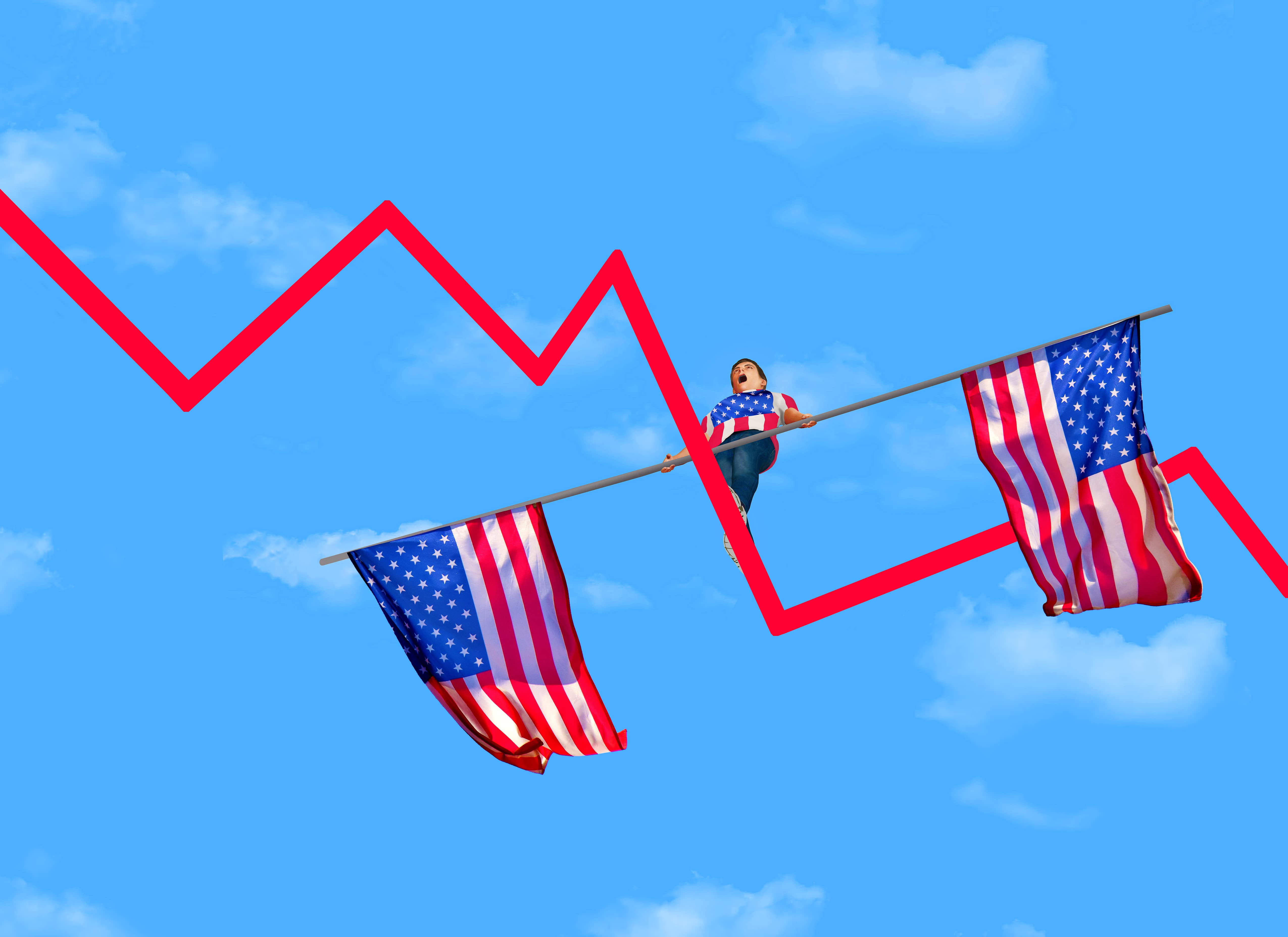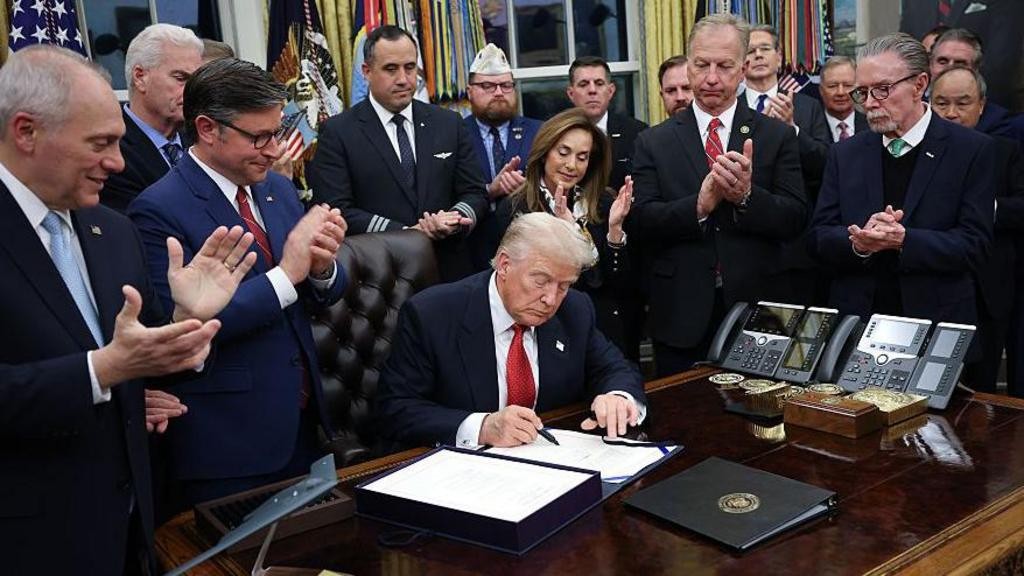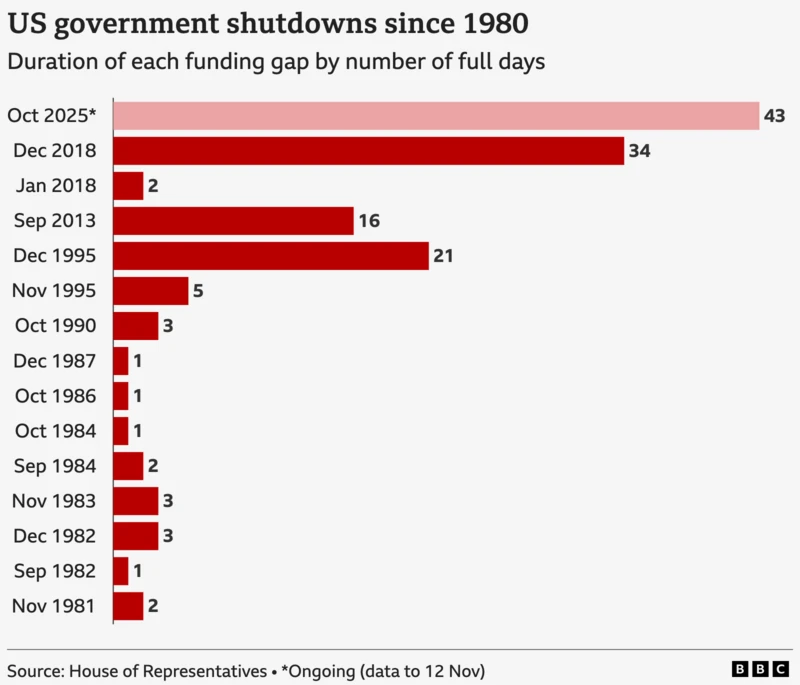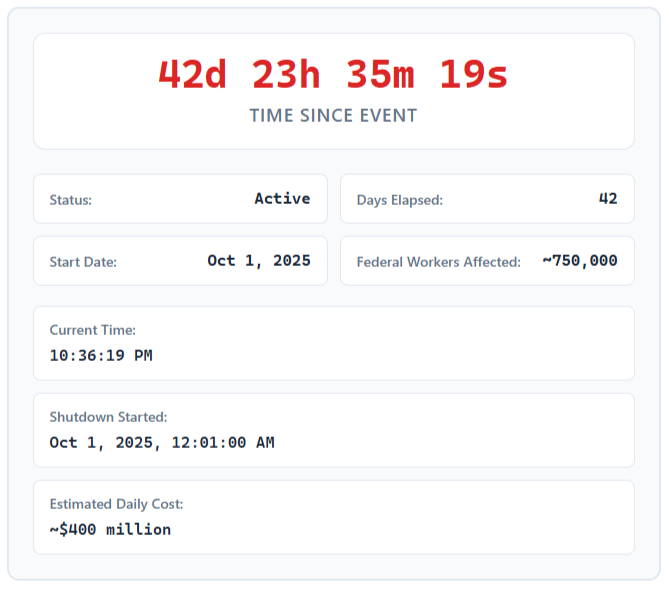市场资讯及洞察

The longest government shutdown in US history has finally ended after 42 long days.
After a month and a half of political theatre, seven Democrats and one independent broke ranks and voted with Republicans to pass a stopgap measure. The Senate went 60-40, the House followed 222-209, and Trump signed it hours later.
The legislation includes three-year appropriations for the Agriculture Department, FDA, military construction, veterans affairs, and congressional operations, along with restoration of pay for federal workers and reversal of Trump administration layoffs through January.
However, the most contentious issue, healthcare subsidies, has been kicked down the road to a December Senate vote.

COVID-era ACA subsidies expire at year-end. When they do, premiums for the average subsidised household will more than double from $888 to $1,904 per year, with an estimated 3.8 million people losing coverage entirely.
If the December vote fails, which is likely considering how far apart the two parties are on the topic, we could see a new shutdown begin in January.

What Happens Next?
This Week:
- Federal employees return to work.
- Paychecks start flowing again.
- SNAP benefits get restored for 42 million people, though heating assistance won't come back for weeks.
- National parks reopen.
- Airports start to go back to normal.
December:
- Senate votes on healthcare subsidies. It will probably fail.
- Premium notices continue to be sent showing 2026 costs doubling.
January 30:
- Government funding expires.
- We do this whole thing over, except now the healthcare subsidies have already expired.
- If Republicans and Democrats remain divided on budget priorities, another shutdown will likely begin.
By the Numbers:
Over the past 42 days, approximately 750,000 federal workers have been furloughed. Another two million worked without pay. Over 42 million had their food assistance delayed. And the FAA cut flights by 10% because air traffic controllers stopped showing up to work.

Further concern is the "data blackout" that has hampered Federal Reserve decision-making. Key economic indicators, including jobs reports, were suspended, leaving the Fed blind during an active rate-cutting cycle.
Meanwhile, separate analyses from Challenger, Gray & Christmas showed layoffs surged 183% in October, which would make it the worst October for jobs since 2003.
The Bottom Line
Today’s deal ended the shutdown, but it didn’t actually solve anything. The deal essentially kicks the can down the road to January while leaving the healthcare crisis unresolved.
With both parties divided on healthcare and spending priorities, and Trump lacking a comprehensive plan to address rising premiums and high deductibles, a resolution in the December vote seems unlikely.
If no compromise is accepted by the time Government funding expires on January 30, another shutdown is almost inevitable.
Impact of Australian Jobs Reports and U.S. Shutdown End on the Aussie


The European Union Top Jobs The European Central Bank (“ECB”) President The European leaders nominated Christine Lagarde, a French lawyer and a politician serving as Managing Director and Chairwoman of the International Monetary Fund ("IMF") as the ECB President. The ECB is responsible for the monetary policy of the nineteen EU member countries. If elected, Christine Lagarde will be the first ECB president without any direct experience in setting central bank policy.
Being a lawyer and a politician rather than an economist, her nomination came as a surprise. However, her experience as the leader of the IMF and as a former French finance minister combined with her comments and opinions on central-banking issues over the years might have reassured governments of EU countries that her nomination will keep the euro-zone monetary policy steady. Christine Lagarde will probably face several challenges: Boosting Growth in the Eurozone Keep the eurozone together despite the rise of populist parties Display independence at a time where central banks’ independence is being threatened amid populist governments.
European Markets The European share market rose on the news of the nomination. Christine Lagarde reinforced the expectations that she will follow the footsteps of Mario Draghi, which is why the prospects of more stimulus package to support the ailing eurozone economy sent European shares higher. World Equity Indices (% Change) Source: Bloomberg Terminal The Shared Currency The Euro struggled to find the upside direction following the recent dovish ECB comments.
The nomination meant that at least in the short-to-mid-term, Christine Lagarde would continue with the easing policies which will oscillate sentiment for the shared currency. The EURUSD pair moved from a high of 1.1371 to a low of 1.1269 this week. EURUSD (1 Month Chart) Source: Bloomberg Terminal Other EU Top Jobs European Commission President: Ursula Von Der Leyen is a German politician servicing as Minister of Defence since 2013.
She will be the 13 th commission president if elected. She will also be the first woman in the post. European Council President: Charles Michel is a lawyer and the interim Belgium Prime Minister who was nominated to replace Donald Tusk.
He resigned over his support for the UN immigration pact but stayed in the caretaker role until the next elections. The convention is that the role is filled by former heads of state and government. European Parliament President: David Maria Sassoli is an Italian politician and a journalist and as President will act as the speaker of the house, chairing debates in the plenary and ensuring parliamentary procedures are followed.
High Representative of the Union for foreign affairs and security policy: Josep Borrell has been Spanish foreign minister under socialist Pedro Sanchez. He will be the chief coordinator and representative of the Common Foreign and Security Policy within the European Union.


A “Dovish” or “Hawkish” Rate Cut The Federal Reserve (Fed) is poised for its first-rate cut in a decade-long of economic expansion. Trade protectionism and a slowing world economy are the two primary factors behind the global push towards easing policies. As the world’s central banks are in a race to cut interest rate to stimulate their economies, the focus will be on the Fed this week which is likely going to engage in its first-rate reversal since the financial crisis.
Source: Bloomberg Terminal It should be highlighted that the US interest rate is still in the low levels despite years of economic growth. It is around half levels it was before the financial crisis. If the Fed starts a rate cut cycle, the central bank will have limited room to lift its economy, in case of future downturns.
American Economy The US economy remains strong, and a look at the recent economic figures may not by its own justify an interest rate cut. However, the Fed is mostly concerned about the slowing world growth, the effects of the ongoing trade war and subdued inflation. The labour market has remained the bright spot of the US economy.
Total nonfarm payroll employment increased by 224k in June and it is forecasted to come around 170k for July. In the latest report, the most prominent jobs gains were in the professional and business services, health care, transportation and warehousing. The unemployment rate in the US is near a 50-year low.
Wages have also risen in the past few days. Growth in consumer spending has also bounced back in the second quarter. Despite a low unemployment and strong overall growth, inflation pressure remains muted which is the source of worry for the central bank.
Gross Domestic Product increased at an annual rate of 3.1% in June. Last Friday, the annual preliminary GDP figure was significantly lower at 2.1% from 3.1% in the first quarter. However, it came above expectations as markets forecasted a drop to 1.8%.
Business Investment growth and the manufacturing sector have slowed notably, and the weak growth is mostly due to trade tensions and the rising threats of trade protectionism. The housing sector is also showing some signs of distress. All in all, the Fed does not see the economy in distress and will likely cut interest rate as a preventative measure.
A 25 or 50 Basis Points ? Market participants are pricing nearly 80% probability of a 25bps and above 20% probability of a 50bps rate cut. There were mixed messages on the dovishness of FOMC members which did not fully convince the markets that the Fed will engage in an aggressive rate cut cycle in the coming months.
If the Fed slashes interest rate this week, it will likely be a quarter-point precautionary cut. If the Fed is cutting interest rate for preemptive reasons in the face of a slowing economy and trade tensions, a 50 basis point might signal that the US economy is in distress which does not seem to be the aim of the Fed. Also, a 50 bps might signal that the Fed made a policy mistake in December in hiking rate.
The rate cut should have pleased President Trump, but President Trump renews attack on the Fed and is already telling the Federal Reserve that the quarter-point cut will not be enough. Stock Market To some extent, the rate cut has already been priced-in at least one rate cut as we have seen some record highs in the stock markets based on the return to the lower rate world. S&P500 reached a record high at 3,027.98 points Source: Bloomberg Terminal Nasdaq Composite reached an all-time high at 8,293.33.
Source: Bloomberg Terminal The ASX200 briefly rose to an all-time high at 6,875 on Tuesday before retreating to high levels seen in 2007. The Australian share market has returned to levels seen before the global financial crisis. Source: Bloomberg Terminal The stock markets are being buoyed mostly by monetary easing policies.
However, the fears of a fragile global trade system and volatile political climate are forcing investors to stay cautious. Yesterday’s tweets from the US President reiterates that actions in the global stock markets are a Tweet Away ! Many dubbed this week as one of the “busiest weeks of the year” because trade negotiations have resumed this week, and the markets are waiting to see if the Fed will lead the global push to lower rates.


Tesla Second Quarter 2019 Update Tesla, the electric car maker, reported its second-quarter earnings on Wednesday in late US trading hours. Despite record production and deliveries, Tesla missed revenue estimates. The company reported a net loss of $408 million.
Its share price fell by more than 20% since the beginning of the year after reaching a high of $380. Source: Bloomberg Terminal After the release of the second-quarter results, we saw a drop of 12% in the after-trading hours. Despite the wider-than-expected loss, the company reported a recovery compared to the first quarter: Net loss declined significantly compared to Q1.
The company ended the quarter with the highest level of cash and cash equivalents, which is $5.0bn. Model 3 has also received the highest ever ratings from stringent testing protocols. Model 3 deliveries reached an all-time record of 77,634 and were the best selling premium vehicle in the US.
Gigafactory Shanghai is taking place, and in quarter 2, they started moving machinery into the facility. The second generation of Model 3 which is a more cost-effective version, could be a long-term opportunity for Tesla. Preparations for Model Y started in Fremont in the second quarter.
Even though the earnings missed expectations, the company has improved, generated free cash flow and is sitting on more capital. “This quarter, we are simplifying our approach to guidance. We are most focused on expanding our manufacturing footprint in new regions, launching new products and continuing to improve the customer experience, while generating and using cash sustainably.” Click here for more information on trading Share CFDs, also, see our Index Trading page for information in trading Indicies.


Record-Highs in the Stock Market Global Stock Market Record Highs Amid geopolitical tensions, mixed earnings report and less-dovish central banks, this week, we still saw some more record highs in the stock market. Nasdaq Composite closed at a record high at 8,321.50 on Wednesday as technology stocks rallied on strong earnings, trade optimism, and a US budget deal at the beginning of the week. S&P 500 also traded at an all-time high at 3,019.56 on Wednesday, which brings its annual percentage change to 19.82%.
However, the momentum slowed down towards the end of the week with mixed earnings and less-dovish central banks. S&P500 widely regarded as the best single gauge of large-cap US stocks dropped by 0.50% while Nasdaq Composite finished 1% lower on Thursday. US500 (S&P500) – 15 Mins Chart Source: GO MT4 In the Australian share market, the All Ordinaries index, the oldest share index, which is made up of 500 largest companies listed on the ASX, reached an all-time at 6,901.90 on Thursday.
Source: Bloomberg Terminal The S&P/ASX200 was just 10 points away from its best close ever. Unlike the ECB, the RBA Governor Lowe was more dovish during his speech stating that “if demand is not sufficient, the Board is prepared to provide additional support by easing monetary policy further.” Major Earnings Reports As the week progressed, earnings went from being strong to mixed. Attention was mostly on the major companies from the FAANG Group.
Amazon: Amazon reported its quarterly updates after the closing bell, and shares of Amazon slipped by 2.5% in the after-hours trading. The company saw earnings of $2.6bn, and revenue was $63.4bn, which is up from the $52.9 billion a year ago. However, the figures came below estimates, and it is the first time Amazon reported income below analysts’ consensus.
The main highlight for Amazon was Prime Day, which was the largest shopping event in Amazon history. The weaker-than-expected profit is mostly due to the investment in expediting deliveries to Prime customers, which the company previously announced. The actual cost of speeding shipping was higher than anticipated, and it will be one of the key metrics investors will be monitoring for the next quarter.
Third Quarter 2019 Guidance Net sales are expected to be between $66.0 billion and $70.0 billion, or to grow between 17% and 24% compared with third-quarter 2018. This guidance anticipates an unfavourable impact of approximately 30 basis points from foreign exchange rates. Operating income is expected to be between $2.1 billion and $3.1 billion, compared with $3.7 billion in third quarter2018.
This guidance assumes, among other things, that no additional business acquisitions, investments, restructurings, or legal settlements are concluded. Source: Bloomberg Terminal Google: Google’s parent company, Alphabet, reported higher than expected revenue at a time where the tech giant is facing increasing scrutiny from the US regulators. The second-quarter revenue is $38.9 bn, which is a rise of 19% compared to 2018 Q2.
Its share price rose more than 7% in the after-hours trading. Source: Bloomberg Terminal Facebook: Facebook’s earnings beat forecasts despite data scandal. The 2019 figures include an additional $2.0 billion legal expense related to the U.S Federal Trade Commission (FTC) settlement. "We had a strong quarter and our business and community continue to grow," said Mark Zuckerberg, Facebook founder and CEO. "We are investing in building stronger privacy protections for everyone and on delivering new experiences for the people who use our services." We also note that Facebook struck a $5 billion settlement with the FTC following the 2018 Cambridge Analytica scandal.
Shares were on the downside despite upbeat results as the CFO expects “more pronounced deceleration in the fourth quarter and into 2020, partially driven by ad-targeting related headwinds and uncertainties”. Source: Bloomberg Terminal


The Main Headlines of the RBA August Statement By Philip Lowe, Governor: Monetary Policy Decision The Board decided to leave the cash rate unchanged at 1.00 per cent. The outlook for the global economy remains reasonable. The persistent downside risks to the global economy combined with subdued inflation have led a number of central banks to reduce interest rates this year and further monetary easing is widely expected.
The Australian dollar is at its lowest level of recent times. Inflation to increase gradually, but it is likely to take longer than earlier expected for inflation to return to 2 per cent. Wages growth remains subdued and there is little upward pressure at present, with strong labour demand being met by more supply.
Conditions in most housing markets remain soft, although there are some signs of a turnaround, especially in Sydney and Melbourne. It is reasonable to expect that an extended period of low-interest rates will be required in Australia to make progress. The Board will continue to monitor developments in the labour market closely and ease monetary policy further if needed to support sustainable growth in the economy and the achievement of the inflation target over time


One Country, Two Systems The Hong Kong protests have reached a point where it is threatening the “one country, two systems” that exists between the special international financial hub and the mainland. It started with demonstrations against the extradition bill which later turned into a movement against the Hong Kong’s government. Millions marched through the streets, groups stormed through government buildings and protesters also brought the city’s international airport to a standstill for two days.
Months of unrest is now taking a toll on the city’s economy. Hong Kong is one of the world’s busiest business locations, and by crippling the airport and the city, companies operating in the financial hub are experiencing some serious disruptions. Does China need Hong Kong to stay as it is?
The autonomy given to Hong Kong back in 1997 when China regained control of the city was mostly respected because China needed the city to remain as it is: “The financial centre of China” The three months of protests forced traders to reassess China’s stance and dependency of Hong-Kong. Back in 1997, China was not part of the World Trade Organisation (WTO). After a lengthy process of negotiations and significant changes to the Chinese economy, China became a member of the WTO.
It means that China no longer has to rely on Hong Kong to get access to the global trade market. In 1997, the special status given to Hong Kong benefitted the mainland economy. However, when we look at the GDP figures over the years, we can see that Hong Kong’s economy relative to China has fallen from 18% to less than 3%.
Hong Kong GDP (US$) China GDP (US$) In 1997 177 Billion 962 Billion In 2018 362 Billion 13 Trillion Source: World Bank China has undergone enormous economic growth over the years and also launched a series of policies to expand its expansion. In terms of growth engines, Hong Kong has been lagging. However, GDP figures alone may not be a good indicator to assess the appeal of Hong Kong relative to China.
Hong Kong has retained the Number 1 title as the world’s freest economy for years and has an economic freedom score of 90.2. When you look at the GDP per capita, Hong Kong outshined China. There is a positive correlation with economic freedom and average GDP per capita.
Countries with more economic freedom tend to have higher GDP per capita income. Source: World Bank Rather than monitoring the economic size, it is more meaningful to use the GDP per capita as an indicator of economic performance to make cross-country comparisons of average living standards and economic wellbeing. GDP per capita is a straightforward division of the total GDP by the population.
The gap in the social, political, cultural and educational development between the city and the mainland is also probably what makes Hong Kong stands out in Asia. Impact of the Protests As Hong Kong battled one of its worst political crises in decades coupled with an escalation of a trade war between the US and China, fears of an immediate recession in Hong Kong are crippling the markets. On Wednesday, it was reported that the private sector activity plunged to a decade-low in August.
The Manufacturing PMI has recorded a decline in the last 17 months. Stocks Hong Kong stocks experienced a sharp pullback over the months. The sell-off sparked by trade tensions were exuberated in Hong Kong due to the protests.
Retail, Property and Casino stocks were among the worst performers after the rallies caused major disruptions to the international airport and transport networks. After weeks of unrest, Carrie Lam offers to withdraw the controversial extradition bill in an attempt to bring some calm. Hong Kong stocks bolstered higher and the MSCI gained by over three standard deviations on Wednesday.
Source: Bloomberg Terminal The Property Index led the gains with nearly 7.5% rise following the announcement on the offer to withdraw of the extradition bill. Source: Bloomberg Terminal Hong Kong Dollar The Hong Kong Dollar has been pegged against the US dollar for decades. The peg has been pretty resilient over the years and has survived a few financial crises.
However, the currency is now faced with: A slowing global economy; A trade war between the US and China; and A domestic social unrest. The Hong Kong Dollar is pegged in a tight range of around HK$7.75 – 7.85. The HKD peg helps in preserving confidence and reducing foreign exchange risk.
Investors are comfortable with the peg as it is much more robust in withstanding currency attacks. Source: Bloomberg Terminal However, amid the global headwinds, the HKD appear to be weakening this year but it is unlikely that the currency will trade significantly outside the currency’s range. The central bank will buy local dollars if it gets too weak and sells to curb excessive strength.
Source: Bloomberg Terminal Overall, it is a solid currency peg which is shielded from the current turmoil. China has refrained from intervening despite threatening to do so as the city remains an important gateway and stable financial centre for China. Beijing considered Shenzhen as the “next” Hong Kong given its strategic location and proximity to Hong Kong.
However, in the near future, no other Chinese city appear to be able to immediately step in the role of Hong Kong’s city.

